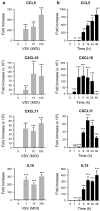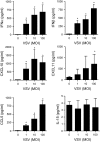Roles of retinoic acid-inducible gene-I-like receptors (RLRs), Toll-like receptor (TLR) 3 and 2'-5' oligoadenylate synthetase as viral recognition receptors on human mast cells in response to viral infection
- PMID: 25550087
- PMCID: PMC4336646
- DOI: 10.1007/s12026-014-8617-x
Roles of retinoic acid-inducible gene-I-like receptors (RLRs), Toll-like receptor (TLR) 3 and 2'-5' oligoadenylate synthetase as viral recognition receptors on human mast cells in response to viral infection
Abstract
To investigate the anti-viral responses of human mast cells, we performed PCR array analysis of these cells after infection with vesicular stomatitis virus (VSV). PCR array analysis revealed that human mast cells up-regulated several anti-viral genes, including melanoma differentiation-associated gene 5, retinoic acid-inducible gene-I, and Toll-like receptor 3, together with type I interferons and chemokines, upon VSV infection. Additionally, we found that 2'-5' oligoadenylate synthetase, which also works as a virus recognition receptor by activating the latent form of RNase L, leading to viral RNA degradation, was up-regulated in human mast cells upon VSV infection. Moreover, small interfering RNA analysis to identify the receptors responsible for mast cell activation by VSV revealed that these receptors reciprocally cooperate to produce anti-viral cytokines and chemokines, inhibiting VSV replication. Our findings suggest that human mast cells produce cytokines and chemokines using several viral recognition receptors, leading to the inhibition of viral replication. These data provide novel information that improves our understanding of the roles of human mast cells in immune responses against viruses.
Figures






Similar articles
-
Expression and functional characterization of retinoic acid-inducible gene-I-like receptors of mast cells in response to viral infection.J Innate Immun. 2013;5(2):163-73. doi: 10.1159/000343895. Epub 2012 Nov 21. J Innate Immun. 2013. PMID: 23171655 Free PMC article.
-
Toll-like receptor 3 and RIG-I-like receptor activation induces innate antiviral responses in mouse ovarian granulosa cells.Mol Cell Endocrinol. 2013 Jun 15;372(1-2):73-85. doi: 10.1016/j.mce.2013.03.027. Epub 2013 Apr 6. Mol Cell Endocrinol. 2013. PMID: 23567548
-
Interferon-Inducible Oligoadenylate Synthetase-Like Protein Acts as an Antiviral Effector against Classical Swine Fever Virus via the MDA5-Mediated Type I Interferon-Signaling Pathway.J Virol. 2017 May 12;91(11):e01514-16. doi: 10.1128/JVI.01514-16. Print 2017 Jun 1. J Virol. 2017. PMID: 28331099 Free PMC article.
-
Retinoic acid-inducible gene-I-like receptors.J Interferon Cytokine Res. 2011 Jan;31(1):27-31. doi: 10.1089/jir.2010.0057. Epub 2010 Oct 15. J Interferon Cytokine Res. 2011. PMID: 20950133 Review.
-
The oligoadenylate synthetase family: an ancient protein family with multiple antiviral activities.J Interferon Cytokine Res. 2011 Jan;31(1):41-7. doi: 10.1089/jir.2010.0107. Epub 2010 Dec 12. J Interferon Cytokine Res. 2011. PMID: 21142819 Review.
Cited by
-
Type I Interferon α/β Receptor-Mediated Signaling Negatively Regulates Antiviral Cytokine Responses in Murine Bone-Marrow-Derived Mast Cells and Protects the Cells from Virus-Induced Cell Death.Int J Mol Sci. 2020 Nov 27;21(23):9041. doi: 10.3390/ijms21239041. Int J Mol Sci. 2020. PMID: 33261178 Free PMC article.
-
RIG-I-like Receptor Regulation of Immune Cell Function and Therapeutic Implications.J Immunol. 2022 Sep 1;209(5):845-854. doi: 10.4049/jimmunol.2200395. J Immunol. 2022. PMID: 36130131 Free PMC article. Review.
-
Prospective, Randomized, Double-Blind Parallel Group Nutritional Study to Evaluate the Effects of Routine Intake of Fresh vs. Pasteurized Yogurt on the Immune System in Healthy Adults.Nutrients. 2024 Jun 20;16(12):1969. doi: 10.3390/nu16121969. Nutrients. 2024. PMID: 38931322 Free PMC article. Clinical Trial.
-
Mast cells and influenza a virus: association with allergic responses and beyond.Front Immunol. 2015 May 18;6:238. doi: 10.3389/fimmu.2015.00238. eCollection 2015. Front Immunol. 2015. PMID: 26042121 Free PMC article. Review.
-
Mast cells: Therapeutic targets for COVID-19 and beyond.IUBMB Life. 2021 Nov;73(11):1278-1292. doi: 10.1002/iub.2552. Epub 2021 Sep 21. IUBMB Life. 2021. PMID: 34467628 Free PMC article. Review.
References
Publication types
MeSH terms
Substances
LinkOut - more resources
Full Text Sources
Other Literature Sources

